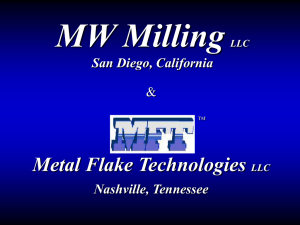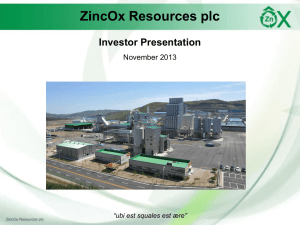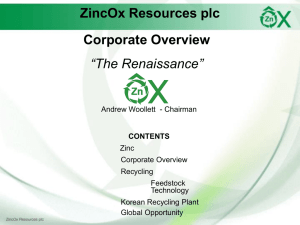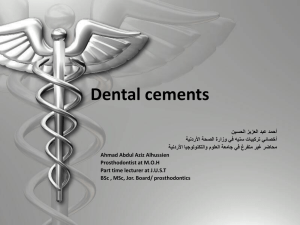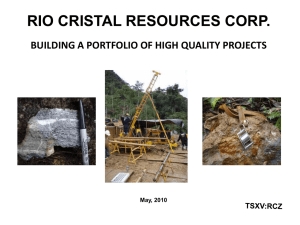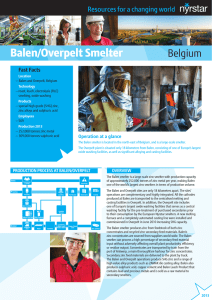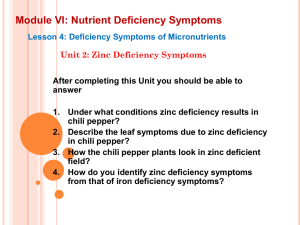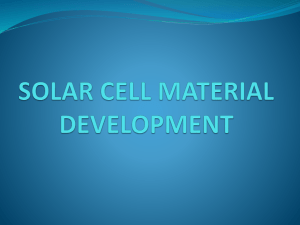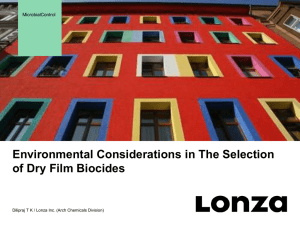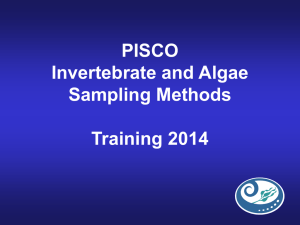Wyatt - University of Oxford
advertisement
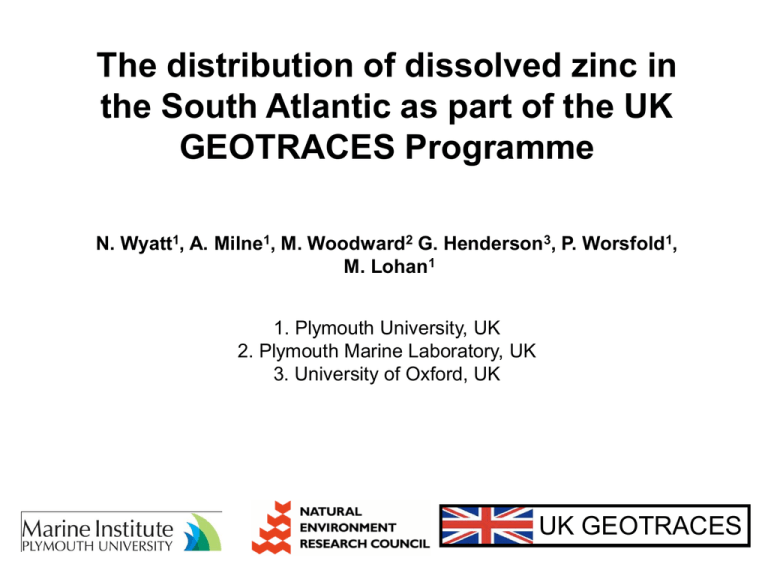
The distribution of dissolved zinc in the South Atlantic as part of the UK GEOTRACES Programme N. Wyatt1, A. Milne1, M. Woodward2 G. Henderson3, P. Worsfold1, M. Lohan1 1. Plymouth University, UK 2. Plymouth Marine Laboratory, UK 3. University of Oxford, UK UK GEOTRACES Zinc • Zinc is a required metal for bacteria and phytoplankton. • Serves as a metal cofactor for important processes, most notably for nucleic acid transcription and repair proteins, in the enzyme alkaline phosphatase and for CO2 uptake via the enzyme carbonic anhydrase. • Vertical profile strongly correlated to the macronutrients Si(OH)4, NO3- and PO43-, suggesting a role for zinc in ocean biogeochemical cycles. • Seawater dZn concentrations range from <10 pM in surface waters to >8 nM in deep waters. • Minor component (~70 ppm) of continental crust • Highly contamination prone element The South Atlantic at 40o S 40o S Satellite derived global chlorophyll concentrations (Sigman and Hain, 2012) Sampling and Analysis Left: Cruise transect map Above: R.R.S James Cook, Cape Town S.A. Sampling and Analysis • Samples collected to ~5200 m using TM clean Ti CTD rosette • Surface (10 m) samples collected by towed FISH • Filtered through 0.2 µm cartridge filter • Total dissolved Zn determined by FIA-FL (Nowicki et al., 1994; Gosnell and Landing, 2012) • Nutrient samples analysed by segmented flow colorimetric auto-analysis (Woodward and Rees, 2001) D357 Total dissolved zinc 1st transect 2nd transect • • Dissolved zinc concentrations range 15 pM – 8.2 nM Concentrations generally increase with depth but slightly decrease between 1500 – 2500 m JC068 Total dissolved zinc • • Dissolved zinc concentrations range 15 pM – 8.2 nM Concentrations generally increase with depth but slightly decrease between 1500 – 2500 m JC068+D357 Total dissolved zinc • • • JC068 with D357 1000 m intergrated. Dissolved zinc concentrations range 15 pM – 8.2 nM. Concentrations generally increase with depth but slightly decrease between 1500 – 2500 m Crossover station 3 Silicate Zinc 0 2 nM 4 6 0 8 20 40 60 uM 80 100 120 140 0 0 1000 1000 JC068 2000 Depth m JC068 D357 3000 4000 5000 Depth m 2000 3000 4000 5000 D357 dZn distribution controlled by water masses UCDW UCDW NADW AABW NADW AABW AAIW UCDW NADW AABW AABW JC068 Zn vs. Si AABW AABW n = 348 • Strong Zn/Si relationship primarily due to uptake and regeneration of Zn by diatoms. • Surface ratio lower due to biological uptake. • Deep water (> 3000 m) ratio suggests a slight underestimation of dZn by up to 6 % in South Atlantic bottom waters. Location Slope R2 n Global deepwater >1000 m 0.052 0.988 211 0.054 0.992 43 0.059 0.941 10 0.040 0.859 130 0.038 0.828 11 0.061 0.981 348 North Pacific Drake Passage Southern Ocean Polar Front 49° 59´ S South Atlantic Reference Marchitto et al. (2000) Bruland (1980) Martin et al. (1990) Croot et al. (2011) Löscher et al. (1999) This study Low Zn D357 – Transect 1 • Zinc and silicate nutricline 500 – 700 m • Nitrate and phosphate nutricline 100 – 400 m • Low zinc concentrations likely linked with the Southern Ocean nutrient return path Low Zn JC068 • Zinc and silicate nutricline 500 – 700 m • Nitrate and phosphate nutricline 100 – 400 m • Low zinc concentrations likely linked with the Southern Ocean nutrient return path Southern Ocean supply of nutrients UCDW NADW AABW 40o S Nitrate data from one of 24 WOCE sections in the Atlantic 40o S 40o S UCDW UCDW NADW AABW NADW AABW UK GEOTRACES SAMW and Si* tracer Sarmiento et al. (2004) • SAMW is main nutrient return path from deep waters of the Southern Ocean to the thermocline of global ocean. • SAMW characterised by high nitrate but low silicate. • Si* = Si(OH)4 – NO3- used to trace movement of SAMW. SAMW and Si* tracer SAMW Future work • Co analysis for D357 and JC068 – November 2012. I will look into the potential limitation patterns of Zn and Co over the three transects. I would hope to recruit the help of Heather and Tom and potential look at their phytoplankton data to determine the groups present along 40 S. • Argentine Basin core samples. The high concentrations of Zn at depth may prove an interesting story and we can now potentially look at the Zn within the core samples. Thanks Will. • Papers. Hopefully two, one based on the Zn/Co distribution across the entire transect and one focusing on the Cape basin seasonal changes in Zn/Co and their potential for limiting biological production. • Particulates? Summary • Zinc is a required metal for bacteria and phytoplankton. • Our aim was to measure dissolved zinc concentrations along 40o S transect and to determine the process that control its distribution and examine the role of zinc in controlling productivity. • Dissolved zinc concentrations ranged 15 pM – 8.2 nM. • The zinc concentrations along 40o S are primarily controlled by the water masses that occupy the area. • We found a significant (R2 0.98) correlation between dissolved zinc and silicate for the entire transect and a


